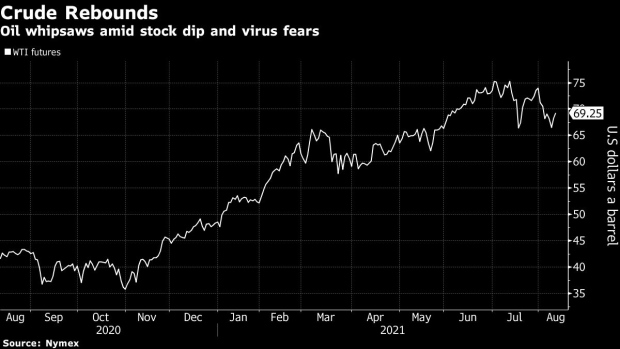Aug 11, 2021
Oil gains as weaker dollar offsets disappointing stockpile draw
, Bloomberg News
Oil rose as a weaker dollar offset a government report that showed a smaller-than-expected decline in crude stockpiles in the wake of a viral resurgence.
Futures advanced more than 1.4 per cent after falling as much as 2.4 per cent earlier when the U.S. called on the OPEC+ alliance to revive production more quickly. The dollar weakened, boosting the appeal of commodities priced in the currency, with data showing consumer prices increased at a more moderate pace in July, reducing concern about an unwinding of some of the stimulus.
“The dollar index is helping out all the commodities and it slipped to the negative side of the equation after the data release today, helping to support the crude market as well,” says Bob Yawger, director of the futures division at Mizuho Securities USA.

Prices were under pressure earlier in the session after the U.S. called on the OPEC+ alliance to revive production more quickly. The world’s largest oil-consuming nation has seen gasoline prices firmly above US$3 a gallon in recent months, putting pressure on drivers who are back on the road as pandemic restrictions ease.
The Energy Information Administration report also showed gasoline stockpiles fell with strong draws in New York Harbor as well as on the West Coast, though overall demand for the fuel slumped. The lackluster shale supply growth is set to tighten markets as the third financial quarter unfolds.
“The weekly report is slightly bearish for oil prices over the short term,” said Brian Kessens, a portfolio manager at Tortoise Capital Advisors. “We saw a lighter- than- expected crude oil draw, and exports that haven’t matched what we saw 12 months ago. All of that is a strong indication that delta is still having an impact on global demand.”
Prices
- West Texas Intermediate for September delivery rose 96 cents to settle at US$69.25 a barrel in New York.
- Brent for October gained 81 cents to end session at US$71.44.
The coalition agreed last month to restart the remaining offline supplies in careful installments, of 400,000 barrels a day each month. The tentative pace seemed in line with the market, which has seen prices soften in recent weeks as the delta variant prompts fresh lockdowns in China and other key fuel consumers in Asia.
However, oil prices haven’t come down fast enough to substantially lower retail gasoline in the U.S., which have been at a seven-year high this summer and source of consternation for the White House.
“While OPEC+’s recent tapering helped stop crude’s ascent, for the White House that’s not enough,” said Bob McNally, president of consultants Rapidan Energy Group and a former White House official. “The Biden administration is under enormous political pressure due to inflation, with galloping gasoline the most publicly visible and vexing.”
Other market news:
- China slashed the quota it allocates to oil refiners to export fuels such as gasoline and diesel, with an academic citing the country’s green targets as one reason behind the dramatic reduction.
- The world’s largest oil companies are bidding up prices for renewable energy projects, squeezing profits from wind and solar farms just as they’re needed most to avoid climate catastrophe.
- Iran’s new president picked the former head of the country’s natural-gas company as oil minister, at a time when the Islamic Republic is engaged in fraught negotiations with world powers to revive petroleum exports.


